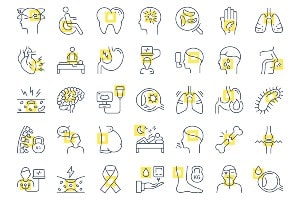About Foot Problems, Diabetes (Foot Problems (Diabetes))

Learn about the disease, illness and/or condition Foot Problems, Diabetes (Foot Problems (Diabetes)) including: symptoms, causes, treatments, contraindications and conditions at ClusterMed.info.
Foot Problems, Diabetes (Foot Problems (Diabetes))

| Foot Problems, Diabetes (Foot Problems (Diabetes)) |
|---|
Foot Problems, Diabetes (Foot Problems (Diabetes)) InformationDiabetes and foot problems facts
Can diabetes-related foot problems be prevented?Some diabetes foot-related problems can be prevented by taking careful steps to observe and care for your feet. Keeping blood sugar levels under control (in the ranges advised by your doctor), and following your recommended diet and exercise program are the best way to prevent all complications of diabetes, including foot problems. In addition to keeping your diabetes under control, you can take steps to care for your feet, including the following:
How are foot problems caused by diabetes treated?Treatment depends upon the type of foot problem. For example, some problems such as corns may require wearing corrective shoes, while others such as mild infections may be treated with antibiotics or antifungals. Other problems may need surgical debridement and antibiotics. Gangrene, or tissue death, cannot be reversed, but treatments are available to prevent gangrene (often termed dry gangrene) from spreading or becoming infected (dry gangrene becomes infected and develops into wet gangrene). Surgical removal of the dead tissue is typically required, and antibiotics are given to prevent the development of life-threatening infections in the dead tissue. In severe cases of gangrene, amputation of the affected part may be necessary.Other types of foot problems can be relieved by proper footwear, sometimes with orthotic devices, and splinting or bracing. For some conditions like hammertoes, bunions, and ingrown toenails; surgery may be necessary to correct severe cases.Taking proper care of your feet (see Prevention section) can help prevent or relieve many common foot problems in people with diabetes. How can diabetes cause foot problems?Both type 1 and type 2 diabetes cause damage to blood vessels and peripheral nerves that can result in problems in the legs and feet. Two main conditions, 1) peripheral artery disease (PAD), and 2) peripheral neuropathy are responsible for the increased risk of foot problems in people with diabetes.
What are the symptoms of foot problems caused by diabetes?In the most severe case, as mentioned above, due to a combination of decreased sensation and reduced blood flow to the feet, ulcers may develop. If the tissues continue to receive insufficient oxygen, tissue death (gangrene) occurs. Gangrene is a serious and potentially life-threatening condition. Other potentially serious problems that may develop include cellulitis (infection of the tissues beneath the skin) and osteomyelitis (infection of the bone); sepsis (the infection spreads to the bloodstream) also is possible.People with diabetes are at increased risk for milder problems with the feet that are not specific to diabetes but may occur more frequently due to problems with the nerves and circulation to the feet.Some of these conditions are: (This list is not exhaustive.)
What is the prognosis for diabetes-related foot problems?The outlook depends upon the severity of the foot problem. As mentioned before, gangrene can be life-threatening if bacterial infection develops in the dead tissue area. Severe gangrene may result in the necessity for amputation of the affected area. Other foot problems are less severe but may nevertheless lead to reduced function or discomfort. Patients need to understand that for the best outcome of foot problems caused by diabetes is life-long monitoring of their feet for problems and consulting their doctor immediately if a problem begins to develop. |
More Diseases
A | B | C | D | E | F | G | H | I | J | K | L | M | N | O | P | Q | R | S | T | U | V | W | X | Y | Z
Diseases & Illnesses Definitions Of The Day
- Noncancerous Colloid Thyroid Nodule (Thyroid Nodules) ‐ How are thyroid nodules diagnosed?, Introduction to thyroid nodules …
- Skin, Laser Resurfacing (Laser Resurfacing) ‐ CO2 Laser Resurfacing, Complications of Laser Skin Resurfacing …
- Malignant Fibrous Histiocytoma (Bone Cancer Overview) ‐ Are there any treatments or medications that relieve bone cancer pain? …
- Double Vision ‐ Is it possible to prevent double vision?, What are the symptoms and signs of double vision? …
- Ageusia (Taste Disorders) ‐ Are taste disorders serious?, Can taste disorders be treated? …
- Autism Screening and Diagnosis ‐
- Alpha-fetoprotein Blood Test ‐ In which situations are high blood (serum) levels of AFP used as a tumor marker? …
- Polymyalgia Rheumatica ‐ How do health care professionals make a diagnosis of polymyalgia rheumatica? …
- Stump Appendicitis (Appendicitis) ‐ Appendicitis definition and facts, Are there long-term consequences of appendectomy? …
- Gonorrhea (Gonorrhea In Women) ‐ Gonorrhea facts, How is gonorrhea diagnosed?, What are sexually transmitted diseases (STDs)? …